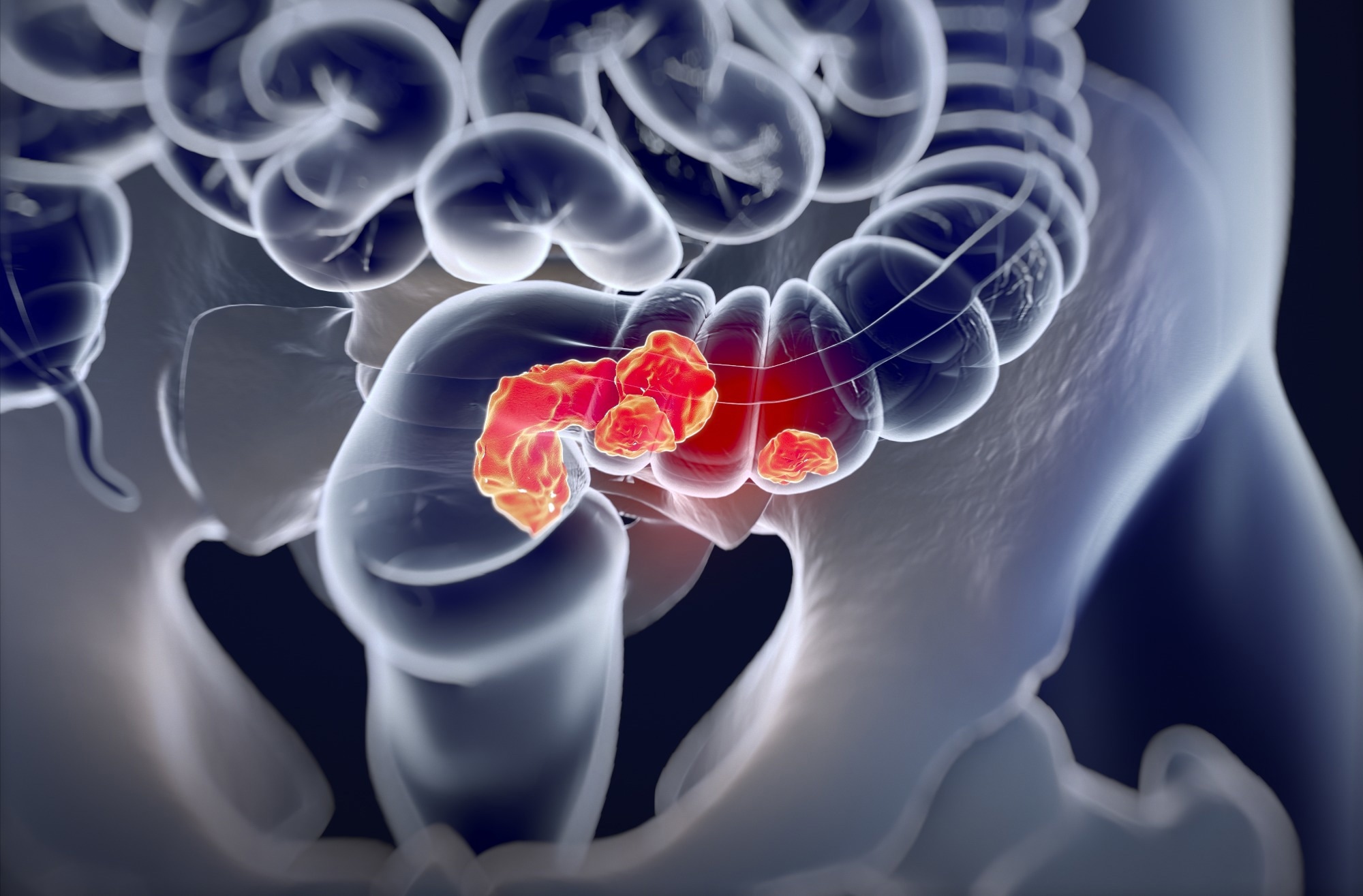 By Neha MathurReviewed by Danielle Ellis, B.Sc.Mar 21 2023
By Neha MathurReviewed by Danielle Ellis, B.Sc.Mar 21 2023In a recent perspective article published in the journal Science, researchers at the Young-Onset Colorectal Cancer Center of Dana-Farber Cancer Institute emphasized that a better understanding of the etiology of early-onset colorectal cancer (EOCRC) is crucial to managing its increasing incidence worldwide. So, they identified five critical areas for investigating EOCRC biology.
 Perspective: A common cancer at an uncommon age. Image Credit: Anatomy Image / Shutterstock
Perspective: A common cancer at an uncommon age. Image Credit: Anatomy Image / Shutterstock
Background
In the United States of America (USA), EOCRC, also known as young-onset colorectal cancer, is predicted to be the leading cause of death in individuals aged 20 to 49 years by 2030. Cases are increasing dramatically among people below 30 years in many countries, including low- and middle-income countries (LMICs).
Patients with EOCRC are often diagnosed with more advanced-stage disease, which could result from a lack of screening that detects early lesions, but this also raises the question of more aggressive biology. The reasons and pathophysiology behind the ever-rising incidence of EOCRC continue to remain unknown. A multidisciplinary path is necessary to understand this increasingly expanding problem.
Core areas of EOCRC biology
Research has shown that patients with Lynch syndrome, characterized by an impaired deoxyribonucleic acid (DNA) mismatch repair pathway, are the most common cause of inherited predisposition to EOCRC.
High levels of microsatellite instability in people with this syndrome also predispose them to other types of cancer. However, pathogenic germline variants observed in Lynch syndrome only partially contribute to the observed rise of EOCRC.
Polygenic risk scores (PRSs) with environmental risk scores could help identify young individuals for tailored CRC screening. Despite this, large-scale genome-wide association studies (GWAS) with gene-environment interaction analyses could better define the contribution of genetic factors to early-onset CRC presentation.
Further, mutational signatures, i.e., distinct patterns of mutations linked to CRC pathogenesis, e.g., excessive consumption of red meat prior to CRC diagnosis and polyketide synthase (PKS) island-expressing genotoxic Escherichia coli (E.coli), could be detected with the aid of whole-genome sequencing (WGS). Their deconvolution from EOCRC-effected people and integration with epidemiological data could later help reveal mutagenic processes contributing to EOCRC tumorigenesis.
Left-sided tumors have different embryologic origins, and they get exposed to variable factors along the gut, which elucidate varying mutational profiles observed across the colon. Due to this, next-generation sequencing panels profiling the somatic mutational landscape of EOCRCs find it tedious to define the molecular landscape of EOCRC, including its clinical and pathologic manifestations.
Intriguingly, an epigenetic feature, hypomethylation of long interspersed nuclear element 1 (LINE-1) transposable elements, also becomes more frequent in younger individuals diagnosed with CRC.
In this regard, single-cell ribonucleic acid sequencing (scRNA-seq) has also played an important role in deciphering cell subsets and genetic programs perturbed in CRC patients, especially older ones. It identified 88 and 204 abnormal cell subsets and gene expression programs, respectively, in CRC.
Transcriptional and epigenetic profiling (at single-cell resolution) of sporadic and inherited premalignant lesions also revealed changes along the CRC tumorigenesis. Together, these methods could uncover the pathophysiology of EOCRC, contrasting with LOCRC yet having some shared features too.
Observational studies have shown that immune cell density, type, and location in the colorectal tumor microenvironment (TME), have prognostic significance. At the same time, molecular epidemiologic studies have shown that lifestyle factors, e.g., lack of activity, could affect the TME of incident cancers.
In addition, scRNA-seq has shown that in primary CRCs, malignant and nonmalignant cells are differentially spatially organized, highlighting how stromal and immune cells facilitate malignant progression.
Metabolic syndromes, such as diabetes mellitus (DM), have globally increased in recent decades, and these factors also possibly increase the CRC risk. In addition, there is an increased trend towards following unhealthy dietary regimens, e.g., processed meat, artificial flavors- and sugar-sweetened beverages, which also increase the risk of cancers, including CRC, in adolescents.
Furthermore, the prevalence of more environmental toxins, higher rates of surgical procedures, and subsequent use of antibiotics added to some other less-recognized risk factors implicated with EOCRC. Nevertheless, this raises the need for prospective studies of the exposome, including early-life exposures to a sedentary lifestyle and unhealthy diet.
There is compelling evidence that gut microbiota, e.g., E. coli and Bacteroidetes fragilis, play a crucial role in CRC pathogenesis and progression. A Chinese study showed that microbes' composition, diversity, and function in fecal matter varied in patients with EOCRC, LOCRC, and same-age healthy controls. Thus, studies of EOCRC should profile the microbiomes in fecal matter and tumors of EOCRC patients.
Conclusions
An in-depth investigation of the interplay between the exposome, tumor-TME, and host is fundamental to revealing the reasons for an observed dramatic rise in the incidence of EOCRC.
Prospective cohort studies examining EOCRC patients alongside healthy individuals should cover serial measurements of the exposome with biospecimen collections, such as blood, tissue, and stool across time; however, it is logistically challenging.
Given that more non-Hispanic Black EOCRC patients die due to EOCRC than White patients, these studies should cover them proportionately. However, the challenge with epidemiologic studies gathering prospective dietary and lifestyle data across the exposome is rare because of the complexity and cost of maintaining cohorts with children, adolescents, and adults.
Global collaborations could facilitate patient and biospecimen collection to accelerate the advancements in this area of research. Likewise, specialized centers focused on EOCRC patients will help provide patients with comprehensive clinical care while enabling multidisciplinary research. Innovative patient recruitment methods, e.g., the Count Me in Colorectal Cancer Project directly partnering with patients, could help accrue data for ongoing and future research.
This fatal disease is grappling younger people more than ever before. Hence, it is crucial to make concerted efforts to screen younger individuals via blood-based biomarkers. Early detection of EOCRC could help prevent, intervene, or successfully treat the affected people.